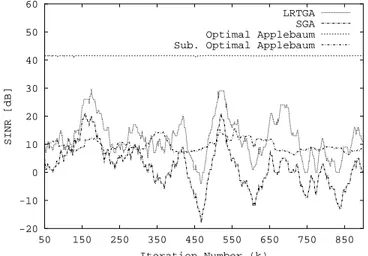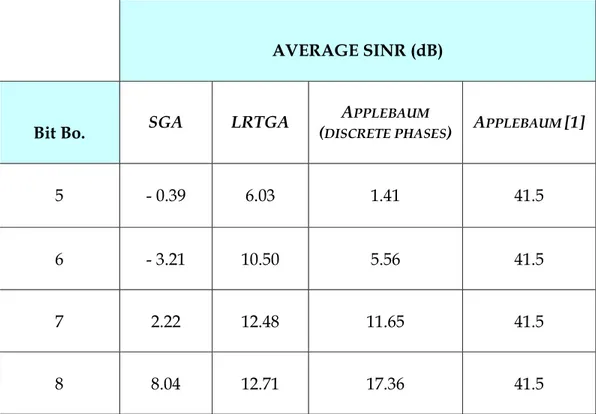UNIVERSITY
OF TRENTO
DEPARTMENT OF INFORMATION AND COMMUNICATION TECHNOLOGY
38050 Povo – Trento (Italy), Via Sommarive 14
http://www.dit.unitn.it
O
N THEU
SE OF AG
ENETIC-B
ASEDA
PPROACH FORA
NTENNAA
RRAYC
ONTROL IN AS
CATTERINGE
NVIRONMENTClaudio Sacchi, Massimo Donelli, Francesco G.B. De Natale,
Andrea Massa, and Andrea Lommi
August 2004
On the Use of a Genetic-Based Approach for Antenna Array
Control in a Scattering Environment
Claudio Sacchi, Massimo Donelli, Francesco G.B. De Natale, Andrea Massa, and Andrea Lommi
Department of Information and Telecommunication Technology (DIT) University of Trento
Via Sommarive 14 I-38100, Trento, Italy
On the Use of a Genetic-Based Approach for Antenna Array
Control in a Scattering Environment
Claudio Sacchi, Massimo Donelli, Francesco G.B. De Natale, Andrea Massa, and Andrea Lommi
Indexing terms: Adaptive Antenna Arrays, Genetic Algorithms
Abstract - In this letter, an approach to adaptive antenna array optimisation based on genetic algorithms is assessed in a realistic scattering environment, where interfering signals are modelled using the Student’s t-distribution. Simulation results demonstrate the effectiveness of the proposed array control strategy.
I.
I
NTRODUCTIONSince the publication of Applebaum’s landmark paper [1], a strong research interest has been focused on the study and development of efficient and computationally practicable algorithms for adaptive antenna array control. As a matter of facts, the optimal solution proposed in [1] requires the full inversion of the signal covariance matrix. Also solutions based on dynamic programming like Least-Mean-Squares (LMS) and Recursive-Least-Squares (RLS), which use the steepest descent theory [2], do not allow practical low-cost implementations [3]. In this framework, procedures based on the Genetic Algorithms (GA) can be regarded as an attractive solution [3][4]. Up to now, the effectiveness of GA-based array optimisation strategies has been assessed by considering simplified channel models [3]. In order to further assess the GA procedure, a scenario characterized by a Poisson-modelled distribution of interference arrivals with stochastic lifetimes is assumed in [4]. In this letter, a more accurate model of the signal transmission is considered, based on the statistical representation of interference arrival angles proposed in [5]. In particular, a GA-based array control strategy, namely the Learned Real-Time Genetic Algorithm (LRTGA) [4], is assessed by considering a multipath channel with Student’s t-distributed angles of arrival. The proposed model is described in Section 2, while Section 3 provides a set of selected simulation results and Section 4 draws the conclusions.
II.
M
ATHEMATICALF
ORMULATIONLet xk(t) be the modulated signals radiated by a mobile transmitter belonging to a
K-user family given by:
( )
{
j ft}
k
k t t e c
x ()=Reγ 2π k =1..K (1)
where γk
( )
t is the complex envelope and f is the working frequency. For a mobile c channel, characterised by scattering phenomena, the received complex signal by the i-th antenna element of a equally-spaced V-element array (being d the inter-element distance) is given by [6]: t f j i R r d i t f j kr r k r i k c kr c r c e t n e c d i t t y λ θ π π φ π θ τ γ α 2 1 sin 2 2 ) ( sin ) ( + − − =∑
= − − (2)where R is the number of signal paths; αr and φr are the r-th attenuation and phase
delay, respectively; τr is the propagation time delay; θk ,r is the angle of arrival
related to the k-th signal and to the r-th path; ni(t) is the additive white Gaussian
background noise; c is the speed-light and λc is the free-space wavelength. Under
narrowband assumption [6], starting from (2) it is possible to define the following low-pass signal:
(
)
∑
= − − − = R r id j r k j r i k kr c r t e e t 1 sin 2 ) ( λ θ π φγ τ α ξ (3)According to [4], the total amount of co-channel interference impinging at the i-th array element is given by:
∑
= = () 1 ) ( ) ( M t k i k i t t I ξ (4)where M(t) is a stochastic process characterised by a Poisson distribution. Without loss of generality, let us assume a two Rayleigh fading paths (R=2) with known deterministic attenuations and phase-delays [5]. Moreover, the stochastic characterisation of the arrival angles,
{ }
θkr , be modelled with a Student’s t-distribution [5] and the interfering signal lifetime limited to χTG, χ being an integer random value uniformly distributed in the range[ ]
0,ζ .The array control problem consists in the optimal choice of the array weights vector,
(
w ae i V)
w j i i
i = ; =1,..,
= ϕ , in order to maximize the
signal-to-noise-plus-interference-ratio (SINR) at the array output [1]:
( ) w w w SINR u T T Λ Ω = * 2 1 2 θ γ (5)
where Ω
( )
θ1 is a phase-related term referred to the desired signal defined in [4] being(
1,1 1,R)
1 ˆ θ ,...,θ
θ = ; Λ is the undesired signal covariance matrix [1] [3] related both to u
the Gaussian background noise, ni(t), and to the co-channel interference,Ii(t); 2 γ is the squared mean value of the slowly time-varying signal envelope. This problem is equivalent to maximizing the following cost function [3]:
( ) ( ) w w w w f y T T Λ Ω = * 2 1 θ (6)
where Λy is the covariance matrix related to the observation vector y [3] [4] (being
( )
t( ) ( )
t I t n( )
t y i ii
i =ξ1 + + ).
As far as the beamforming system is concerned, the array control is achieved by means of digital phase shifters with fixed Dolph-Chebyschev amplitude coefficients, {ai}. Consequently, the LRTGA-based optimization procedure maximizes (5) by
searching for an optimal configuration of the discrete phase coefficients only. To this
end, the GA-chromosome, φ={ϕ1,...,ϕN}, encodes the phase coefficients, ϕi being the
coded-representation of i-th phase shift trial solution. The adaptive strategy is carried out by a real-time tuning of GA probabilities Pc (crossover probability) and Pm
(mutation probability) according to a “learning strategy” defined in [4].
III.
N
UMERICALA
SSESSMENTIn the numerical validation, the transmission carrier-to-single interference ratio (C/I) has been set to –30dB, whereas the signal-to-background noise ratio is equal to 30dB. The parameter ζ has been set equal to 10. As an example, Figure 1 shows a sample realization of Student’s t-distributed angle of arrivals with two degrees of freedom [5].
As far as the digital phase shifter is concerned, the number of bits for phase discretization has been set equal to 7. In this scenario, the proposed GA-based approach has been compared with a standard GA (SGA), with the Applebaum’s method (using unfeasible continuous phases [1]), and with a realistic implementation of the Applebaum’s criterion (with discrete phases). Figure 3 shows the resulting running averages of the SINR. It can be observed that LRTGA can significantly improve the adaptation capabilities of the SGA-based control algorithm, achieving an average SINR equal to 12.48dB (average SINR = 2.22dB for the SGA method). Moreover, despite the optimality of the method in [1], the SINR attained by the LRTGA is almost equivalent on average to the one achieved by Applebaum’s method with discrete phases (average SINR = 11.65dB), even if the latter considers continuous modules. Table 1 shows the corresponding average SINR values and confirms the improvement in robustness of LRTGA with respect to SGA. For the sake of completeness, it is to be mentioned that SINR values provided by sub-optimal
Applebaum’s strategy get closer to optimal ones for an increasing number of phase quantization levels, whereas LRTGA does not improve significantly its performance (see Tab. 1). Such phenomenon becomes evident in phase shifters using 8 bits or more. Nevertheless, a large number of phase quantization levels inevitably involve unacceptable hardware costs, making them unsuitable for marketable implementations.
IV.
C
ONCLUSIONSIn this letter, a suitable GA-based strategy for adaptive antenna array control was assessed in a realistic mobile scattering environment. The performance attained by LRTGA was compared with the optimal solution in terms of SINR values. Simulation results showed the robustness of the proposed array control strategy with respect to conventional approaches, particularly when low-cost hardware implementations are required.
R
EFERENCES[1] S. P. Applebaum, “Adaptive arrays,” IEEE Trans. Antennas Propagat., Vol. A.P-24, No. 5, pp. 585-598, September 1976.
[2] B. Widrow, P. E. Mantey, L. J. Griffiths, B. B. Goode, “Adaptive antenna systems,” IEEE Proc., 1967, Vol. 55, pp. 2143-2159.
[3] D. S. Weile, E. Michielssen, “The control of adaptive antenna arrays with genetic algorithms using dominance and diploidy,” IEEE Trans. Antennas Propagat., vol. 49, No. 10, pp. 1424-1433, Oct. 2001.
[4] M. Donelli, A. Lommi, A. Massa, C. Sacchi, “Assessment of the GA-Based Adaptive Array Control Strategy: The Case of Stochastic Life-Time Co-Channel Interferences”, Microwave and Optical Technology Letters, Vol. 37, No. 3, May 5, 2003, pp. 198-201.
[5] J. Bach-Andersen, K. Ingemann-Pedersen, ”Angle-of-Arrival Statistics for Low Resolution Antennas,” IEEE Trans. Antennas Propagat., vol. 50, No. 3, pp. 391-395, March 2002.
[6] D.R. Van Rheeden, S.C. Gupta, “A Temporal Smoothing Approach to Direction of Arrival Estimation of Coherent Signals in Fading Channels”, Proc. of IEEE WNCN 1999 Conf., Vol.1, pp. 286-290.
F
IGUREC
APTIONS• Figure 1.
Scattered interferers direction of arrivals vs. GA iteration number. • Figure 2.
Running average SINR vs. GA iteration number (7-bit digital phase shifter).
T
ABLEC
APTIONS• Table I.
-90 -60 -30 0 30 60 90 0 100 200 300 400 500 600 700 800 900 θ Iteration Number (k)
-20 -10 0 10 20 30 40 50 60 50 150 250 350 450 550 650 750 850 SINR [dB] Iteration Number (k) LRTGA SGA Optimal Applebaum Sub. Optimal Applebaum
AVERAGE SINR (dB)
Bit Bo. SGA LRTGA
APPLEBAUM
(DISCRETE PHASES) APPLEBAUM [1]
5 - 0.39 6.03 1.41 41.5
6 - 3.21 10.50 5.56 41.5
7 2.22 12.48 11.65 41.5
8 8.04 12.71 17.36 41.5


